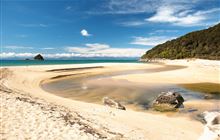Abel Tasman islands restored to being predator free
Archived content: This media release was accurate on the date of publication.
Introduction
Three Abel Tasman National Park islands are now predator free again after a 2017 operation successfully eradicated mice on the islands, says DOC.Date: 26 March 2019
Monitoring since the DOC operation has confirmed there are now no longer mice on Adele/Motuareronui, Fisherman/Motuareroiti and Tonga islands which are used as predator-free sanctuaries for native species.
DOC is reminding island visitors their help is crucial to keeping mice, rats and other pests off the islands, so they remain safe for native species living there.
DOC Operations Manager Chris Golding says there a risk of mice and rats re-invading the islands through hitching a ride on visiting vessels.
“People planning to go to the islands should check before going out on the water that boats, kayaks, all bags, containers, food and gear are clear of mice, rats, ants, spiders or other animals. All clothing, footwear and gear should be free of soil and plant material, including seeds and foliage.
“We want people to enjoy the nature experience on the two islands that can be visited, Adele and Fisherman, but we need all visitors to make sure they don’t have stowaway pests onboard that could escape onto the islands.”
Rats are a threat to South Island robins/toutouwai and saddlebacks/tīeke that have been returned to Adele Island and to robins that have spread to Fisherman Island. Rats and mice threaten insects and lizards and they eat seeds, suppressing re-vegetation. Mice can even eat small birds’ eggs and nestlings.
DOC first carried out an operation to eradicate mice from the islands in 2007. Mice were found back on the islands in 2015 when mice numbers were high in the park due to heavy beech seed fall that provided more food and fuelled their breeding. The 2017 operation was carried out to restore the islands to being predator free.
Rats and stoats can swim the around 800 m distance from the park mainland to the islands. Mice are not thought to be able to swim more than 500 m but it’s possible they may have swum from the Abel Tasman mainland to the islands.
The Abel Tasman islands have biosecurity measures in place to help protect them from invading predators, including traps to catch them and tracking tunnels that record footprints to detect them. DOC staff have reviewed and strengthened these measures to detect predators earlier so they can be quickly eradicated before their numbers build.
DOC, Project Janszoon and the Abel Tasman Birdsong Trust work in partnership to try to keep the islands free of predators and to restore the islands’ ecology.
Public access is not allowed except by permit on Tonga Island to protect the island’s New Zealand fur seal breeding colony from disturbance. The seals can be viewed from vessels on the sea.
Background information
DOC works in partnership with iwi, Project Janszoon and the Abel Tasman Birdsong Trust to restore the ecology of the Abel Tasman National Park, including its islands.
Project Janszoon is a privately funded trust named after Dutch explorer Abel “Janszoon” Tasman. It's working with DOC, the Abel Tasman Birdsong Trust, the community and iwi, to reduce predator numbers and weeds, restore eco-systems and re-introduce native birds, animals and plants in the Abel Tasman.
The Abel Tasman Birdsong Trust is a partnership between Abel Tasman tourism operators, the community and DOC. It was set up in 2007 with the aim of preserving and enhancing the natural environment in and around Abel Tasman National Park. It raises funds for and undertakes pest control and other conservation programmes.
Contact
Jacqui Irwin, Community Ranger
Mobile: +64 27 269 3150
Email: jairwin@doc.govt.nz

